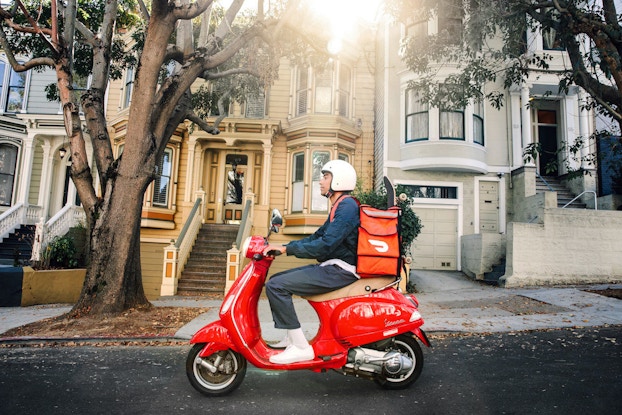
3 ways technology is altering the way we shop for food and fashion to furniture:
- As pandemic-changed consumers want their food delivered in a New York minute, a patchwork of players, from legacy retailers like Albertsons to newbie Gopuff to unlikely partnerships such as Amazon Prime and Grubhub, are tapping tech to drop off groceries in as little as 15 minutes.
- Augmented reality tech—tech that enables shoppers to try on clothes without stepping into a dressing room via virtual avatars or visualize how a retailer’s couch will look in their living room—is becoming more widely available.
- The work-from-home movement has given rise to hospitality and real estate tech startups like Sonder and Casai that cater to remote employees with office amenities and apartment features such as a full kitchen designed for long-term stays.
At any given time across the nation, the buying occasions that pepper consumers’ everyday lives increasingly reflect technology-touched moments like these: A San Diego shopper texts with a Sephora beauty expert on finding the right post-vacation-tan foundation shade. Some 2,000 miles away in Granville, Ohio, another consumer mulls how Crate & Barrel’s disco-inspired office chair looks in the family den via the magic of virtual reality, then books a much-needed London “workation” on apartment rental and hotel platform Sonder.
In the post-internet era that’s seen the-next-big-digital thing sizzle then fizzle (rest in peace, Amazon Dash buttons), experts say this next-gen tech is gaining noteworthy adoption among consumers and brands alike, so attention must be paid.
Here’s a look at the technology that’s making an imprint on how we buy fashion, food, beauty, home goods and travel experiences.

Fashion: Digital-fit solutions help shoppers — including online shoppers — ‘make more accurate purchase decisions’
A growing number of fashion tech solutions designed to both offer shoppers custom-fit garments and tackle the pain point of buying clothes online are popping up at retailers, from FIT:MATCH’s mall-based body scanning studios to Walmart’s new "Choose My Model" digital experience.
The nation’s biggest retailer entered the virtual fitting room space with its 2021 acquisition of tech startup Zeekit to slay one of the most vexing aspects of shopping for clothes online: “understanding how an item will actually look on you,” said Denise Incandela, Executive Vice President of Apparel and Private Brands for Walmart U.S., in a company blog this spring.
Shoppers on Walmart’s app and Walmart.com select a virtual model that matches their height, body shape, and skin tone, then try outfits on their digital paper doll to gauge how an item will look on their flesh-and-blood shelves.
“Digital fit solutions are important,” Jane Hali, founder of investment research and retail/brand consulting firm Jane Hali & Associates, told CO—. “They allow customers to generate a 3D representation of themselves online by uploading images of themselves. Depictions of these, created through the use of artificial intelligence, can help shoppers make more accurate purchase decisions by viewing how clothing fits their body.”
Essentially, the omnichannel [shopping] trend that we’ve been talking about for 20 years has finally truly become omnichannel, and doing it well is critical in the highly competitive beauty arena.
Michelle Kluz, partner, Kearney
Food: Pandemic stokes heightened demand for instant-delivery eats among internet-tethered consumers
As e-commerce sales surged amid the pandemic, so did consumer expectations around superfast service, notably same-day and 15-minute food and grocery delivery. A patchwork of companies ranging from legacy retailers like Target to third-party players such as Instacart are heeding the call via digital tech. At the same time, unlikely alliances have formed — Albertsons and DoorDash, Amazon Prime meets Grubhub — to deliver food to consumers in a New York minute.
It's a sign of the times, said Jonah Ellin, Chief Product Officer at 1010data, a retail data analytics firm. “Always connected to the internet, people can request anything be brought anywhere at nearly anytime,” he told CO—. “Fulfillment is through companies making use of the same technologies matching supply to the demand, leveraging a gig economy where anyone with a mobile device can become the last mile in the supply chain.”
Beauty: Bringing the in-store human touch to online shopping with service-driven digital tools
The beauty sector is investing in ways to bring the expertise of in-store experts to online consumers via digital tools designed to bridge the service gap.
Sephora’s Live Beauty Help function, for example, connects digital customers with a beauty advisor who can chat live on everything from the best conditioner for bouncy curls to bridesmaids’ gifts under $50, from 9 a.m. to 7 p.m., seven days a week.
As retailers removed in-store testers from beauty counters, “COVID really accelerated the trend of both digital tools and online consults, as people were buying makeup for their virtual events,” Michelle Kluz, a partner in the consumer practice of global strategy and management consulting firm Kearney, told CO—.
“I don’t expect this trend to go away, even as both in-store testers and in-store consults are largely back. Instead, now that consumers have become more comfortable with buying digitally, I believe it will continue to grow and can serve as a good bridge to building loyalty, brand affinity, and ultimately, driving additional in-store loyalty,” Kluz said. “Essentially, the omnichannel [shopping] trend that we’ve been talking about for 20 years has finally truly become omnichannel, and doing it well is critical in the highly competitive beauty arena.”
Home goods: AR tech drops a digital sofa into your living room while personalizing furniture shopping
When the pandemic shuttered stores, retailers — who were already flirting with augmented reality (AR) technology to help consumers see how a sofa would fit in their living room — watched the technology gain appeal.
These days you’d be hard pressed to find a major home furnishings retailer that doesn’t offer a way to visualize a midcentury modern sofa in your apartment without it physically being there: There’s Target’s See It in Your Space, Amazon’s View in Your Room, and Crate and Barrel’s View in My Room, to name a few, notes Ellin.
Brands are tapping AR tech to make good on what’s increasingly valued as the holy grail of customer experiences these days: personalization. “Personalization without the wait is being accomplished in a number of ways, ranging from custom-fit [merchandise] derived from photos captured on mobile devices to brands enabling customization and design online so that customers can plan their own look and try it out virtually,” he said. “In the case of furniture, they can see how items will look in a room adding them via app and mobile image in real time,” Ellin said, “and in some cases you’re able to simulate how they look together.”
[Read: Work-From-Anywhere Isn’t Going Away: 5 Ways the Hospitality Sector Is Monetizing the Trend]

Hospitality experiences: Digital platforms that monetize the work-from-home movement
The work-from-home movement has given rise to hospitality and real estate platforms courting remote employees with “work-from-anywhere” and “workation” (work-meets-vacation), messaging, leaning into what’s shaping up to be a long-term lifestyle shift.
These tech platforms are also targeting consumers, now untethered from the offices in their hometowns, free to book long-term stays in far-flung places. They include businesses like home sharing startup Casai and apartment rental and hotel platform Sonder, which offers guests the option of long stays, as well as suites with apartment-style features like a full kitchen.
The startups reflect the related trend of “travel tech” that capitalizes on pandemic-driven developments, according to a report by business intelligence firm Speeda Edge, “and a trend toward experience-rich wellness travel.”
CO— aims to bring you inspiration from leading respected experts. However, before making any business decision, you should consult a professional who can advise you based on your individual situation.
Follow us on Instagram for more expert tips & business owners’ stories.
CO—is committed to helping you start, run and grow your small business. Learn more about the benefits of small business membership in the U.S. Chamber of Commerce, here.








